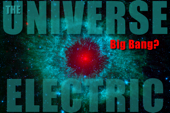Is the Universe Electric?
04/22/08
[EDITOR'S NOTE:
The following is an excerpt from a new e-Book written by Michael
Goodspeed (in collaboration with David Talbott and Wallace Thornhill),
Is the Universe Electric? -- a 23-page, full-color
introduction to and overview of the Electric Universe theory. The e-book is an
expanded version of an essay that was recently published in the
largest graphic magazine in Japan, "Kaze no Tabibito."
The excerpt below deals primarily with the fundamental differences between
plasma cosmology and Big Bang theory. Other sections address the electric
sun; electrically charged planets; electrical scarring of planets; plasma
formations in the lab and in rock art; and the electric comet.
At just 23 pages, the e-Book is intended as a compressed and highly readable
presentation for both the initiated and uninitiated alike. If you choose to
purchase this product, you will be helping support the continuing efforts of
the Thunderbolts Project to promote the electric universe theory -- a theory
that is gathering extraordinary momentum, and promises to revolutionize
science's understanding of the Universe, and our place in it.]
IS THE UNIVERSE ELECTRIC?
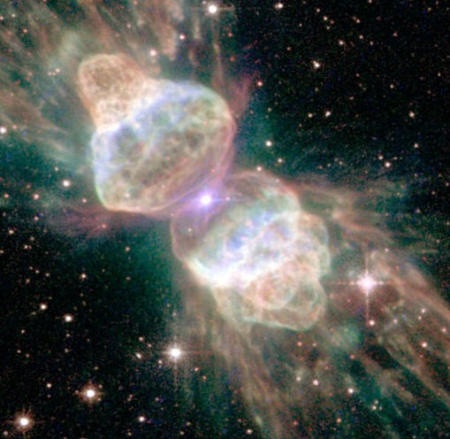
The Ant nebula, Mz3 (rotated). Image Credit: NASA, Space Telescope
Science Institute
Mankind's greatest feat of the 20th century was arguably his journey(s)
into the vast domain of space. When the first man walked on the moon in
1969, it signified an extraordinary leap in technological evolution,
and was a unifying achievement for the entire human race. Astronauts
became the heroes of boys and girls everywhere, and space travel, the
"final frontier" of human endeavor, emerged as an underlying
theme of most science fiction. Authors and filmmakers looked to space
to answer the largest philosophical and spiritual quandaries. And space
adventures became mythic allegories, illuminating the human condition.
Prior to the Space Age, in the first half of the 20th century, Albert
Einstein redefined Sir Isaac Newton's gravitational model of physics.
He combined the three measurable physical dimensions of space with the
additional dimension of time, in something that is now popularly termed
a "continuum" of space and time. This was the foundation of
relativity theory, and Einstein's apparent successes encouraged armies
of mathematicians to follow his lead continually extending his work
into untested territory. One unfortunate result was that astronomy
rapidly became a field dominated by abstract mathematics. In fact, many
critics suggest that it is now almost impossible to distinguish
astronomical theory from science fiction, as mathematicians describe a
universe that, to a dismaying degree cannot be seen, measured, or tested
in any practical way.
For the better part of two centuries, astronomers have believed that
gravity dominates the heavens. The scientific consensus is that
approximately 13.7 billion years ago, the Universe began with a primordial
explosion called the Big Bang. Debris from this theoretical event created
a vast cloud of particles, from which galaxies, stars, planets, and all
other celestial bodies eventually formed, under gravitational influences.
In our own cosmic neighborhood, we are told that the Sun is powered by an
internal nuclear furnace, and that all the planets and moons are isolated
bodies that have moved with predictable precision for billions of years.
It is also claimed that far removed from the Sun, a cloud of debris
produced the icy bodies that we call comets. Periodically, astronomers
say, a few of these bodies are dislodged from the cloud, falling toward
the Sun, to produce the familiar cometary displays. And all of space is
an inert "vacuum" in which electricity plays no significant role.
ELECTRIC PIONEERS

Kristian Birkeland's portrait from a 200 Kroner bank note.
Source: Jacob Lewis Bourjaily, Department of Physics, Princeton University
But space discovery has a habit of contradicting astronomical theory. As
early as the late 19th century, a number of scientific pioneers began
recording their observations of electrical phenomena in space, and
documenting experimental analogs in the laboratory. One such pioneer, the
Norwegian physicist Kristian Birkeland, theorized that the earth's auroras
are powered electrically by charged particles from the Sun. For many decades,
the scientific mainstream dismissed Birkeland's hypothesis, but in the early
1970's Birkeland was irrefutably validated when satellites detected in the
auroras the magnetic signatures of electric currents (called Birkeland
currents) tracing to solar activity. More recently, NASA's THEMIS spacecraft
stunned scientists when it imaged giant, "magnetic ropes" that
reached all the way from the earth to the Sun--a pathway for the charged
particles from the Sun, now known to light the auroras.
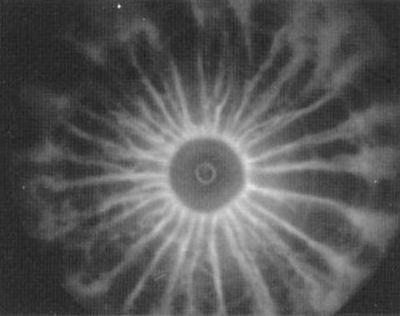
The Nobel Prize-winning Swedish physicist Hannes Alfvén further
developed Birkeland's work, and developed a revolutionary model for the
role of plasma in the cosmos. Through extensive laboratory experimentation,
Alfvén and other plasma pioneers discovered that many space phenomena
could be replicated in the laboratory in plasma experiments. These include
the dense plasma focus (pictured above), a plasma machine that produces, by
electromagnetic acceleration and compression, short-lived plasma that is so
hot and dense that it becomes a copious multi-radiation source. Whereas
mainstream cosmologists rely on exotic, invisible, and internally
inconsistent theoretical inventions to explain the "surprising"
X-ray and radio emissions we observe in space, plasma cosmologists are able
to reproduce these phenomena in a manner that exemplifies the scientific method.
This should come as no surprise, because it is now known that all of space is
permeated by plasma, which makes up over 99.9% of the visible Universe.
Plasma is often mischaracterized as a "gas," but its conductivity
and dynamic response to electricity and magnetism distinguishes it from a gas.
The "quasi-neutrality" of plasmas means they tend overall to be
electrically neutral. But plasmas can also violate quasi-neutrality, producing
charged regions in electrical double layers (DLs) and particle beams. Plasma
is a better conductor of electricity even than copper, and it is this
characteristic that allows for electrical circuitry throughout the cosmos.
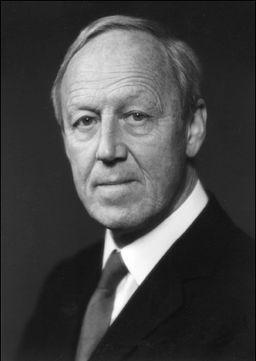
Hannes Alfvén Photo credit: Welinder Jaeger Bergne
Alfvén and his colleagues also established that the behavior of
electrified plasma can be scaled up an incredible 14 orders of magntiude
-- what is observed in the laboratory can occur at galactic dimensions as
well. Furthermore, the electric force is incomparably more powerful than
gravity. Electric currents across cosmic distances have the power to shape
cosmic structure, and at the local scale, to light the sun, to energize
planetary auroras, and periodically, to create spectacular comets.
Alfvén is now recognized as the father of "plasma cosmology.
" In this model of cosmic evolution, it was primarily electromagnetic
forces that organized matter throughout the Universe. It is now
indisputable that magnetic fields pervade the Universe, and Alfvén
noted that these fields cannot exist without the contribution of ELECTRIC
currents. In 1970, in his acceptance speech for the Nobel Prize for
Physics, Alfvén admonished his colleagues that their models must
ultimately fail if they ignored experimental plasma science and the role of
electric currents in space. His warning went unheeded.
FAILURES OF BIG BANG COSMOLOGY
Mainstream cosmology's foundation was built on one of the most popular
scientific theories of the 20th century, the Big Bang. This theory envisions
all of the Universe continually expanding as the result of the primordial,
explosive birth event. But according to an increasing number of critics,
the Big Bang theory has already lost its theoretical underpinning. Astronomers
believe that the Universe is expanding based on their interpretation of a
phenomenon observed in space called "redshift." This describes a
shift toward longer wavelengths of the spectral lines emitted by a celestial
object. Mainstream theorists believe that the object moving from the Earth
causes this. But on many occasions, this belief has been definitively refuted.
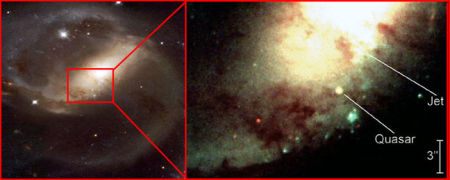
Left Galaxy NGC 7319. Right: A recently
discovered quasar in front of the galactic core. Credit: Jane C.
Charlton (Penn State) et al., HST, ESA, NASA
In the 1960's, the astronomer Halton Arp began documenting instances
where two or more galaxies and highly redshifted quasars were associated,
or even physically connected. Arp's findings contradicted the assumption
that their different galactic redshifts meant that the quasar should be
millions or even billions of light-years farther away than the galaxy.
A dramatic demonstration of this is seen in the galaxy NGC 7319 (picture
above). This galaxy is shrouded with such heavy dust clouds that they
obscure most of the bright, active nucleus that defines a galaxy of this
type. The galaxy has a redshift of 0.0225. In front of its opaque gas
clouds, or embedded in the topmost layers of the dust, is a quasar with a
redshift of 2.114. What does this tell us? By the Big Bang principles, the
quasar must be billions of light years farther from us than the galaxy,
because its redshift is so much larger. And yet the galaxy is opaque, so
the quasar must be near the surface of the dust clouds or even in front
of them.
PLASMA COSMOLOGY VS. BIG BANG
In the eyes of plasma cosmology, celestial objects' redshift is proportional
to current density and electrical stress. In other words, if an object has a
very high redshift, it is not because it is very far away, but rather because
it is in the early stage of a formation in a cosmic plasma discharge.
Faintness and high redshift signify youthfulness not distance. If astronomers
could simply recognize the undeniable existence of electric currents in space
(as Alfvén implored them to), then the picture of space would be
forever altered.
Another problem for Big Bang cosmology has been the appearance of "clumps
" and "voids" in the Cosmos. Critics argued that raw subatomic
-- or preatomic -- material expanding outward at nearly the speed of light
would produce an evenly distributed cloud with no force present to generate
cosmic structure. But in fact, we observe cosmic structure everywhere we look,
and the distribution of matter is profoundly uneven. Both the concentrations of
matter, and the "voids" between these concentrations, falsify the
inherent, logical "predictions" of the original theory.
The force of gravity is weak and takes time to move things around. The elapsed
time since the conjectured Big Bang sets a limit on how big any structure can
be. Structures exceeding that limit are, by the cosmologists' own admission,
impossible. But astronomers have observed "huge voids" when mapping
the Cosmic Microwave Background (CMB) - areas of space where the "
temperature" of the CMB is interpreted as lower than that of the
surrounding region. But in a plasma universe, the appearance of a vast and
remote "void" may be entirely illusory. It is now evident that
astronomers imagine they are seeing things at the far edges of the visible
Universe that are actually occurring in our own cosmic neighborhood, the Milky
Way galaxy. The research of radio astronomer Gerrit Verschuur has demonstrated
that the "cosmic microwave background" shown by WMAP is foreground
microwave fog. So the "vision" of observers using WMAP is clouded by
the local activity of electric current filaments in the Milky Way.
And just as "huge voids" constitute a problem, BB theorists must
wrestle at the other end of the spectrum, with massive galactic structure
which, by their own measuring stick (redshift = distance interpretation),
must have formed in the first phases of cosmic evolution.
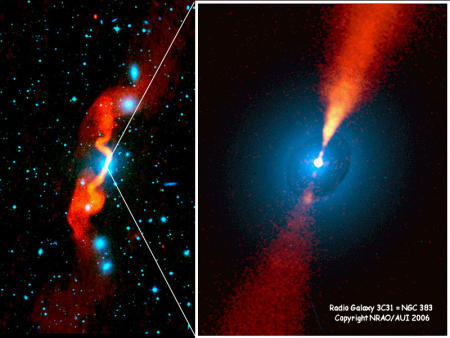
We see the signs of electrical influences everywhere in the Cosmos, but
astronomers remain impervious to these telltale clues. Consider the image
above of the Radio Galaxy 3C31 (also called NGC 383). This galaxy is a
MINUSCULE object, little more than a dust mote, when seen against an
immense display of highly energetic charged particles. Electrons in twin
polar jets, accelerated to near the speed of light are the witnesses to
the most intense electrical discharge activity known to science. Our
instruments detect this activity through its synchrotron radiation and
through the twin lobes of high-energy radio signals. So how is this huge
region of electrical activity to be interpreted? In standard models, an
electrically-neutral galaxy is asked to generate electrical activity
across volumes of space THOUSANDS of times greater than the volume of
the galaxy. But simple electrodynamics says this is impossible! How does
a galactic-size, neutral object produce a vast domain of electrical
activity around it? A plasma cosmologist looking at this image will see
electric currents incomparably larger than the galaxy, being focused down
by a plasma "pinch," at energy levels capable of lighting and
organizing stars into the ubiquitous galactic spiral structure.
But mainstream astronomers who see this picture can only imagine that
a "supermassive black hole" - a nearly infinite compression
of matter which they assure us exists in the heart of every galaxy -
is devouring material and "spitting it out" to produce X-ray
energies. But it's imperative that we understand what astronomers
actually mean when they claim to "see" a black hole. Long
before scientists began speculating about "dark matter" and
"dark energy" (invisible and undetectable entities which we
are told make up 96% of the Universe) astrophysicists observed that
galactic cores exhibit vastly more concentrated energetic activity than
could be achieved by gravity alone, unless something hugely massive
(yet incredibly small) were present. So they effectively "divided
by zero." They employed the near zero force of gravity to explain
a nearly "infinite" compression of matter -- the only thing
they could imagine under their theoretical assumptions. It's no longer
physics; it is a bizarre mathematical conjecture. They called these
speculative, monstrous concentrations of matter "black holes,"
imagining that they "consume everything around them."
As technology improved, the original black hole theoretical model was
quickly contradicted by the observed ejection of vast quantities of
matter in thin jets. Suddenly, the theorists imagined that an "
accretion disk" and magnetic field (which they claim can somehow
exist with no contribution from electric currents) could produce a
narrowly-confined jet across millions of light years.
So let's understand this, very clearly -- scientists have never
"seen" black holes. They've seen (unanticipated) energetic
effects that they imagine can only be caused by the in-fall of matter,
i.e. a theoretical black hole "sucking" and "consuming
" everything around it due to its supposed (but impossible) near
-infinite gravity. Popular discussion of black holes can only be
described as disingenuous in the extreme. The contradictory, unexpected
observations are routinely presented as evidence confirming black holes'
existence! The improbable jets have never had a reasonable place within
gravitational dogma, a fact rarely, if ever, acknowledged in scientific
media.
But the abstract and purely mathematical reasoning that led to black
holes is wholly unnecessary, according to proponents of the Plasma Universe
and Electric Universe. Far from the spotlight of media attention, plasma
cosmologists did anticipate many of the "surprising" discoveries
of the space age, with no requirement of invisible, non-testable material
and objects and mathematical models involving imaginary infinities....
[To continue reading, you may purchase the e-Book (USA $4.00) through
our
online store.]
Permalink to this article.
Public comment may be made on this article on the
Thunderbolts Forum/Thunderblogs (free membership required).
For a highly-acclaimed 60-minute video introduction to the Electric Universe, see
Thunderbolts of the Gods on Google Video.
|

Michael Goodspeed is a freelance journalist who lives in Beaverton, Oregon
My Archives
Chronological Archives
Archives by Author
Archives by Subject
Thunderblogs home
|








